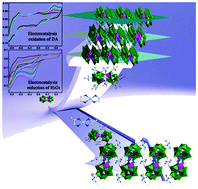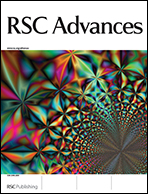A unique hybrid compound with dimeric monocopper-substituted Keggin polyoxoanions as ten-connected linkages, [Cu5(en)9][(PW11CuO39)2]·18H2O (1) (en = ethylenediamine), has been synthesized and characterized by elemental analysis, IR, TG analysis, powder X-ray diffraction and single-crystal X-ray diffraction. In 1, each dimeric Keggin [PW11CuO39]210− cluster as an unusual deca-dentate connector links ten [Cu(en)2]2+ complexes to form a three-dimensional (3D) framework with a (44·832·129) topology. The successful synthesis of 1 provides a feasible route for us to design and prepare high-connectivity and high-dimensionality hybrid compounds with the dimeric substituted polyoxoanions as linkages. Furthermore, the electrochemical studies have shown that 1 has bifunctional electrocatalytic activity towards not only the reduction of normal inorganic molecules hydrogen peroxide (H2O2) and potassium iodate (KIO3) ascribed to the W-centers in [PW11CuO39]210−, but also the oxidation of biologic molecules ascorbic acid (AA) and dopamine (DA) ascribed to the Cu-centers in [Cu5(en)9][(PW11CuO39)2]·18H2O.

You have access to this article
 Please wait while we load your content...
Something went wrong. Try again?
Please wait while we load your content...
Something went wrong. Try again?


 Please wait while we load your content...
Please wait while we load your content...